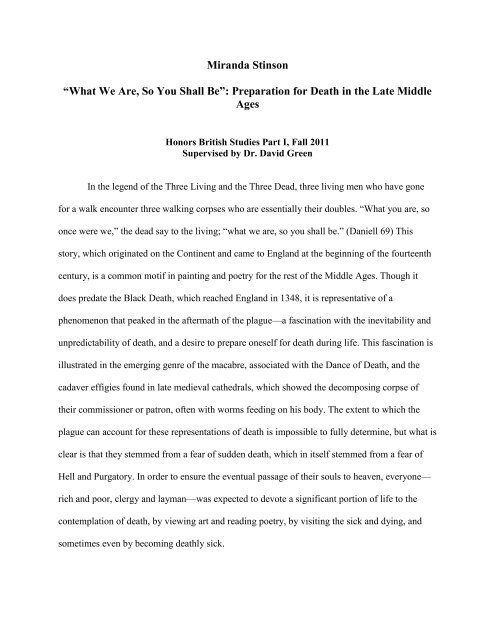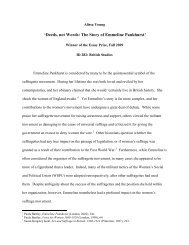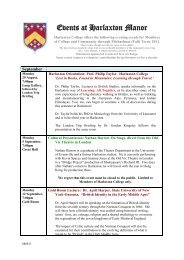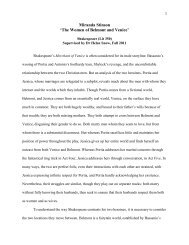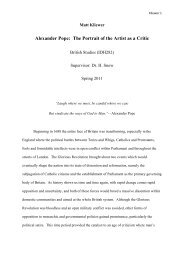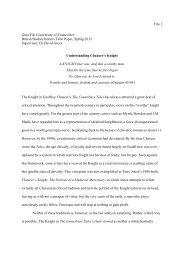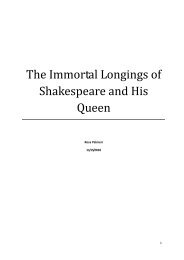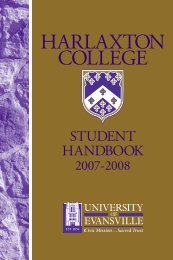“What We Are, So You Shall Be”: Preparation for Death in the Late ...
“What We Are, So You Shall Be”: Preparation for Death in the Late ...
“What We Are, So You Shall Be”: Preparation for Death in the Late ...
You also want an ePaper? Increase the reach of your titles
YUMPU automatically turns print PDFs into web optimized ePapers that Google loves.
Miranda St<strong>in</strong>son<br />
<strong>“What</strong> <strong>We</strong> <strong>Are</strong>, <strong>So</strong> <strong>You</strong> <strong>Shall</strong> <strong>Be”</strong>: <strong>Preparation</strong> <strong>for</strong> <strong>Death</strong> <strong>in</strong> <strong>the</strong> <strong>Late</strong> Middle<br />
Ages<br />
Honors British Studies Part I, Fall 2011<br />
Supervised by Dr. David Green<br />
In <strong>the</strong> legend of <strong>the</strong> Three Liv<strong>in</strong>g and <strong>the</strong> Three Dead, three liv<strong>in</strong>g men who have gone<br />
<strong>for</strong> a walk encounter three walk<strong>in</strong>g corpses who are essentially <strong>the</strong>ir doubles. <strong>“What</strong> you are, so<br />
once were we,” <strong>the</strong> dead say to <strong>the</strong> liv<strong>in</strong>g; “what we are, so you shall be.” (Daniell 69) This<br />
story, which orig<strong>in</strong>ated on <strong>the</strong> Cont<strong>in</strong>ent and came to England at <strong>the</strong> beg<strong>in</strong>n<strong>in</strong>g of <strong>the</strong> fourteenth<br />
century, is a common motif <strong>in</strong> pa<strong>in</strong>t<strong>in</strong>g and poetry <strong>for</strong> <strong>the</strong> rest of <strong>the</strong> Middle Ages. Though it<br />
does predate <strong>the</strong> Black <strong>Death</strong>, which reached England <strong>in</strong> 1348, it is representative of a<br />
phenomenon that peaked <strong>in</strong> <strong>the</strong> aftermath of <strong>the</strong> plague—a fasc<strong>in</strong>ation with <strong>the</strong> <strong>in</strong>evitability and<br />
unpredictability of death, and a desire to prepare oneself <strong>for</strong> death dur<strong>in</strong>g life. This fasc<strong>in</strong>ation is<br />
illustrated <strong>in</strong> <strong>the</strong> emerg<strong>in</strong>g genre of <strong>the</strong> macabre, associated with <strong>the</strong> Dance of <strong>Death</strong>, and <strong>the</strong><br />
cadaver effigies found <strong>in</strong> late medieval ca<strong>the</strong>drals, which showed <strong>the</strong> decompos<strong>in</strong>g corpse of<br />
<strong>the</strong>ir commissioner or patron, often with worms feed<strong>in</strong>g on his body. The extent to which <strong>the</strong><br />
plague can account <strong>for</strong> <strong>the</strong>se representations of death is impossible to fully determ<strong>in</strong>e, but what is<br />
clear is that <strong>the</strong>y stemmed from a fear of sudden death, which <strong>in</strong> itself stemmed from a fear of<br />
Hell and Purgatory. In order to ensure <strong>the</strong> eventual passage of <strong>the</strong>ir souls to heaven, everyone—<br />
rich and poor, clergy and layman—was expected to devote a significant portion of life to <strong>the</strong><br />
contemplation of death, by view<strong>in</strong>g art and read<strong>in</strong>g poetry, by visit<strong>in</strong>g <strong>the</strong> sick and dy<strong>in</strong>g, and<br />
sometimes even by becom<strong>in</strong>g deathly sick.
St<strong>in</strong>son 2<br />
It is tempt<strong>in</strong>g to expla<strong>in</strong> <strong>the</strong> late medieval attitude toward death as a direct result of <strong>the</strong><br />
Black <strong>Death</strong>, which caused massive loss of life and brought about a new awareness of <strong>the</strong> fact<br />
that death could come at any time. While this generalization is not completely false, <strong>the</strong>re are<br />
several issues of tim<strong>in</strong>g. The fear of sudden death was not new. The adm<strong>in</strong>istration of <strong>the</strong> Last<br />
Rites was an essential part of pre- and post-plague ritual, and a sudden death without <strong>the</strong>se rites<br />
could leave <strong>the</strong> soul <strong>in</strong> danger of be<strong>in</strong>g corrupted or sent to Hell. Even be<strong>for</strong>e <strong>the</strong> plague, artists<br />
and writers were fasc<strong>in</strong>ated by death, and by <strong>the</strong> difference between <strong>the</strong> liv<strong>in</strong>g and <strong>the</strong> dead. As<br />
mentioned earlier, <strong>the</strong> legend of <strong>the</strong> Three Liv<strong>in</strong>g and <strong>the</strong> Three Dead predates <strong>the</strong> plague: it had<br />
certa<strong>in</strong>ly arrived <strong>in</strong> England by no later than 1303, when a diptych illustrat<strong>in</strong>g <strong>the</strong> story was<br />
purchased from France (B<strong>in</strong>ski 135). There are questions of chronology <strong>in</strong> <strong>the</strong> orig<strong>in</strong>s of <strong>the</strong><br />
cadaver effigy as well. “[A]s a simple explanation,” argues Pamela K<strong>in</strong>g, “<strong>the</strong> Black <strong>Death</strong> is<br />
both too early and too late” (qtd. <strong>in</strong> Platt 183). It is too late to expla<strong>in</strong> <strong>the</strong> <strong>in</strong>terest <strong>in</strong> graphic<br />
representation of <strong>the</strong> dead but too early to expla<strong>in</strong> <strong>the</strong> cadaver effigy itself, which did not reach<br />
England until 1420 and was not found anywhere be<strong>for</strong>e <strong>the</strong> plague (Daniell 184).<br />
In consider<strong>in</strong>g <strong>the</strong> <strong>in</strong>fluence of <strong>the</strong> Black <strong>Death</strong>, it is important to understand that, as<br />
Christopher Daniell states, “such a huge number of deaths did not change <strong>the</strong> core of traditional<br />
<strong>the</strong>ology or religion,” which was still focused on avoid<strong>in</strong>g Hell and lessen<strong>in</strong>g one’s time <strong>in</strong><br />
Purgatory. It did not cause a major shift <strong>in</strong> doctr<strong>in</strong>e, as <strong>the</strong> Re<strong>for</strong>mation did. To understand<br />
medieval religion, it is essential to understand <strong>the</strong> medieval def<strong>in</strong>itions of body and soul.<br />
Accord<strong>in</strong>g to current doctr<strong>in</strong>e, <strong>the</strong> body and <strong>the</strong> soul were two dist<strong>in</strong>ct entities, and death was<br />
def<strong>in</strong>ed as <strong>the</strong> moment when <strong>the</strong>y separated. The soul rema<strong>in</strong>ed unharmed despite <strong>the</strong> death of<br />
<strong>the</strong> body; though death was <strong>in</strong>evitable, <strong>the</strong> soul could be saved, and this was <strong>the</strong> crux of medieval<br />
religious practice. Prayers <strong>for</strong> <strong>the</strong> souls of <strong>the</strong> dead were important, and those with wealth and
St<strong>in</strong>son 3<br />
power could found chantries and request masses to be said <strong>for</strong> <strong>the</strong>ir souls; <strong>the</strong> number of masses<br />
was a status symbol, and often <strong>the</strong> richest requested over a thousand masses (1).<br />
Just as important as prayers after death, however, was ritual per<strong>for</strong>med dur<strong>in</strong>g life,<br />
especially <strong>the</strong> Last Rites—Penance, <strong>the</strong> Eucharist, and Extreme Unction—per<strong>for</strong>med by a priest<br />
immediately be<strong>for</strong>e <strong>the</strong> <strong>in</strong>dividual’s death. The most significant of <strong>the</strong>se was Extreme Unction,<br />
“a ritually trans<strong>for</strong>mative act from which <strong>the</strong>re was no return.” (B<strong>in</strong>ski 29) It could be disastrous<br />
if an <strong>in</strong>dividual died be<strong>for</strong>e this rite could be per<strong>for</strong>med, but it also posed a problem if he did not<br />
die after it had been per<strong>for</strong>med. Extreme Unction “marked <strong>the</strong> end of one’s material existence, so<br />
those who received it without actually be<strong>in</strong>g dead had no proper place <strong>in</strong> religious understand<strong>in</strong>g<br />
(Green 38). They were “latter-day Lazaruses, walk<strong>in</strong>g corpses.” (B<strong>in</strong>ski 29) Thus it was<br />
important to be able to predict one’s time of death, at least to some extent, and <strong>the</strong> Last Rites<br />
were usually not per<strong>for</strong>med until “<strong>the</strong> last possible moment” (Green 38).<br />
This, however, was not <strong>the</strong> only reason to fear sudden death, or mors improvisa. (Green<br />
48) It was essential to have purified oneself of s<strong>in</strong> because, it was believed, “<strong>the</strong> Devil would<br />
take advantage of <strong>the</strong> weakened state of dy<strong>in</strong>g s<strong>in</strong>ners to try and make <strong>the</strong>m fall <strong>in</strong>to heresy,<br />
superstition, or cause <strong>the</strong>m to lose faith” (50). Thus death itself was a test, and a “good death”<br />
was one that had been properly prepared <strong>for</strong>. It was necessary to understand that death comes to<br />
all, <strong>the</strong>re<strong>for</strong>e to repent of one’s s<strong>in</strong>s be<strong>for</strong>e it was too late. This is <strong>the</strong> message of <strong>the</strong> Three<br />
Liv<strong>in</strong>g and <strong>the</strong> Three Dead. In a French text circa 1310, <strong>the</strong> Third Dead K<strong>in</strong>g says,<br />
…know<br />
That I was head of my l<strong>in</strong>e;<br />
Pr<strong>in</strong>ces, k<strong>in</strong>gs and nobles<br />
Royal and rich, rejoic<strong>in</strong>g <strong>in</strong> my wealth;<br />
But now I am so hideous and bare<br />
That even <strong>the</strong> worms disda<strong>in</strong> me. (qtd. <strong>in</strong> B<strong>in</strong>ski 136)
St<strong>in</strong>son 4<br />
Thus commoners and k<strong>in</strong>gs alike are entreated to contemplate death. It was expected that people<br />
visit both tombs and sickbeds, and it was believed that “see<strong>in</strong>g someone die encouraged<br />
conversion, as <strong>the</strong> awareness of mortality made clear <strong>the</strong> necessity of secur<strong>in</strong>g salvation.”<br />
<strong>So</strong>me, however, sought more than an empa<strong>the</strong>tic experience of death. The mystic Julian<br />
of Norwich (1342-c.1416) wished <strong>for</strong> a “bodilye syekenes…so hard as to <strong>the</strong> dede…<strong>for</strong> I hoped<br />
that it might be to me a spede when I shulde die” (qtd. <strong>in</strong> Apple<strong>for</strong>d 195). She wanted to die and<br />
yet live—<strong>for</strong> herself and o<strong>the</strong>rs to believe she was dy<strong>in</strong>g, and to be given <strong>the</strong> Last Rites. What<br />
<strong>for</strong> o<strong>the</strong>rs would have been a terrify<strong>in</strong>g prospect—to become, essentially, a zombie—was <strong>for</strong> her<br />
a God-given privilege, as she did eventually have a near-death experience, just as she had<br />
wished. (195)<br />
The late medieval attitude toward sickness was conflicted. On <strong>the</strong> one hand, disease was<br />
usually evidence of s<strong>in</strong>, “<strong>in</strong>dicative of <strong>the</strong> general spiritual malaise of humanity, or <strong>the</strong><br />
consequence of div<strong>in</strong>e punishment of an <strong>in</strong>dividual.” On <strong>the</strong> o<strong>the</strong>r hand, a long illness allowed<br />
sufferer to prepare <strong>for</strong> death—to put his affairs <strong>in</strong> order, to write a will, and, most important, to<br />
repent his s<strong>in</strong>s. Doctr<strong>in</strong>e had no way of gett<strong>in</strong>g around <strong>the</strong> fact that <strong>the</strong> virtuous were ill just as<br />
much as <strong>the</strong> s<strong>in</strong>ful, and it was acknowledged that “a difficult death could follow a relatively<br />
virtuous life.” Fur<strong>the</strong>rmore, it was often believed that one who suffered a long illness was<br />
undergo<strong>in</strong>g an earthly Purgatory, which meant that it would take him fewer years to reach<br />
Heaven. (Green 43) If <strong>the</strong> end of such an illness could be predicted, this was also to be praised.<br />
Accord<strong>in</strong>g to Daniell,<br />
Once <strong>the</strong> <strong>the</strong>mes had been established—that <strong>for</strong>e-knowledge of death was good, and<br />
sudden death was bad—<strong>the</strong>re was only a very short logical step to assum<strong>in</strong>g that good<br />
people would have <strong>for</strong>eknowledge, and that bad people…would die suddenly. (71)
St<strong>in</strong>son 5<br />
The problem, of course, with this idea is that death is impartial, as <strong>the</strong> Three Liv<strong>in</strong>g and<br />
<strong>the</strong> Three Dead suggests, and this is one way <strong>in</strong> which <strong>the</strong> <strong>in</strong>fluence of <strong>the</strong> Black <strong>Death</strong> is<br />
<strong>in</strong>controvertible. <strong>Death</strong> from plague was always sudden, and it wasn’t just <strong>the</strong> wicked who were<br />
<strong>in</strong> danger of dy<strong>in</strong>g without receiv<strong>in</strong>g <strong>the</strong> Last Rites. The religious desperation of this time was<br />
reflected <strong>in</strong> <strong>the</strong> actions of <strong>the</strong> Bishop of Bath and <strong>We</strong>lls, who “issued a remarkable letter to his<br />
clergy, which stated that not enough priests could be found” to adm<strong>in</strong>ister <strong>the</strong> rites. The Bishop<br />
declared that any layman, even a woman if necessary, could hear confession, and <strong>the</strong> Eucharist<br />
could be given by a deacon. “If, however,” <strong>the</strong> Bishop wrote, “<strong>the</strong>re is no priest to adm<strong>in</strong>ister <strong>the</strong><br />
Sacrament of Extreme Unction, <strong>the</strong>n, as <strong>in</strong> o<strong>the</strong>r matters, faith must suffice.” This was one ritual<br />
that even <strong>the</strong> plague could not change. (Daniell 192)<br />
The primary factor <strong>in</strong> late medieval attitudes toward death was still, as stated earlier,<br />
religious belief, but it undeniable that <strong>the</strong> Black <strong>Death</strong> gave <strong>the</strong>m a new level of mean<strong>in</strong>g.<br />
(Daniell 195) Cadaver effigies were often commissioned by those who wished to meditate on<br />
<strong>the</strong>ir own deaths <strong>in</strong> advance, and <strong>the</strong>y often, accord<strong>in</strong>g to Platt, had noth<strong>in</strong>g to do with sudden<br />
death; never<strong>the</strong>less, <strong>the</strong>ir connection to “unsecured death by plague” would have been evident<br />
(Platt 158-159). And although pa<strong>in</strong>t<strong>in</strong>gs and texts of <strong>the</strong> Three Liv<strong>in</strong>g and <strong>the</strong> Three Dead were<br />
common be<strong>for</strong>e <strong>the</strong> Black <strong>Death</strong>, Platt argues that “it was <strong>in</strong> its later post-plague treatments that<br />
<strong>the</strong> legend lost its levity,” com<strong>in</strong>g <strong>in</strong>to “<strong>the</strong> same spirit as <strong>the</strong> contemporary Dance of <strong>Death</strong>”<br />
(183-184).<br />
After <strong>the</strong> Re<strong>for</strong>mation, writes Platt, “<strong>the</strong> art of <strong>Death</strong> lived on…<strong>for</strong> <strong>the</strong> plague (unlike <strong>the</strong><br />
Pope) had not been banished. It is impossible to say dist<strong>in</strong>ctly how much of <strong>the</strong> fasc<strong>in</strong>ation with<br />
dy<strong>in</strong>g well, and <strong>the</strong>re<strong>for</strong>e with prepar<strong>in</strong>g <strong>for</strong> death, was a result of <strong>the</strong> plague and how much was<br />
<strong>the</strong> result of religious doctr<strong>in</strong>e and belief, but what is certa<strong>in</strong> is that it was a dist<strong>in</strong>ctly medieval
St<strong>in</strong>son 6<br />
phenomenon. By <strong>the</strong> Age of Reason, when “<strong>the</strong> risks of an untimely death subsided,” as had <strong>the</strong><br />
fear of Purgatory with <strong>the</strong> Re<strong>for</strong>mation over a century earlier, so subsided <strong>the</strong> need to spend life<br />
prepar<strong>in</strong>g <strong>for</strong> death. But until that time, cadaver effigies and motifs such as <strong>the</strong> Three Liv<strong>in</strong>g and<br />
<strong>the</strong> Three Dead rema<strong>in</strong>ed popular, and everyone, regardless of status was encouraged to look on<br />
<strong>the</strong>m and contemplate <strong>the</strong>ir own mortality. As <strong>the</strong> Three Dead were, so would <strong>the</strong>y someday be,<br />
and constant rem<strong>in</strong>der of this fact was <strong>the</strong>ir best hope of sav<strong>in</strong>g <strong>the</strong>ir souls.<br />
Works Cited<br />
Apple<strong>for</strong>d, Amy. “The ‘Comene Course of Prayers’: Julian of Norwich and <strong>Late</strong> Medieval <strong>Death</strong><br />
Culture.” The Journal of English and German Philology, 107 (2008), 190-214.<br />
B<strong>in</strong>ski, Paul. Medieval <strong>Death</strong>: Ritual and Representation. British Museum Press: London, 1996.<br />
Daniell, Christopher. <strong>Death</strong> and Burial <strong>in</strong> Medieval England: 1066-1550. Routledge: London,<br />
1997.<br />
Giesey, Ralph E. “Review: ‘Metamorphosis of a <strong>Death</strong> Symbol: The Transi Tomb <strong>in</strong> <strong>the</strong> <strong>Late</strong><br />
Middle Ages and <strong>the</strong> Renaissance’ by Kathleen Cohen.” Speculum, 52 (1977), 637-41.<br />
Green, David. “Mascul<strong>in</strong>ity and Medic<strong>in</strong>e: Thomas Wals<strong>in</strong>gham and <strong>the</strong> <strong>Death</strong> of <strong>the</strong> Black<br />
Pr<strong>in</strong>ce.” Journal of Medieval History, 35 (2009), 34-51.<br />
Platt, Col<strong>in</strong>. K<strong>in</strong>g <strong>Death</strong>: The Black <strong>Death</strong> and Its Aftermath <strong>in</strong> <strong>Late</strong>-Medieval England. UCL<br />
Press: London, 1996.


